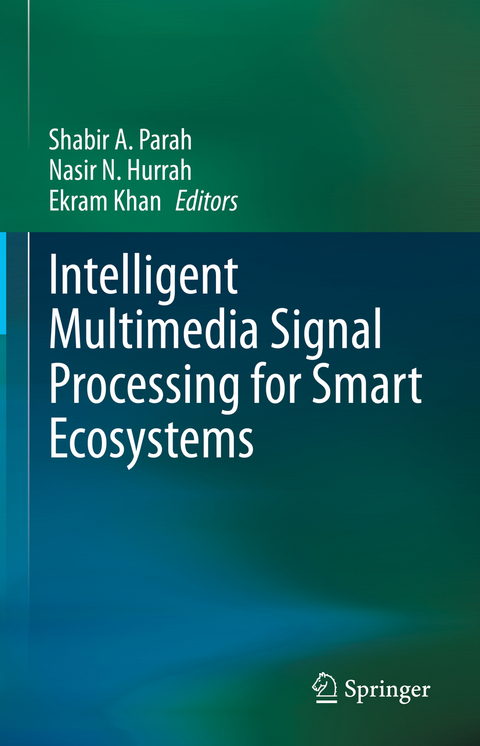
Intelligent Multimedia Signal Processing for Smart Ecosystems
Springer International Publishing (Verlag)
978-3-031-34872-3 (ISBN)
Shabir Parah: Shabir A. Parah received M. Phil. and Ph.D. Degrees from University of Kashmir in 2010 and 2013 respectively. He was awarded Junior Research Fellowship (JRF) by University Grants Commission in the Year 2008, and subsequently worked as UGC-Junior Research Fellow from January 2009 to May 2010. In May 2010, he joined as Assistant Professor in the Department of Electronics and Instrumentation Technology, University of Kashmir. He is leading Signal Processing and Communication Engineering (SPACE) Research group at the Department of Electronics and Inst. Technology. His research interests include, Medical Image Processing, E- healthcare, Covert Communications, Digital Watermarking, Reversible Data Hiding, Adaptive digital filter design, Image compression and coding, Information Security and Spintronics. He is author of more than 150 publications in International and National journals/conferences. Besides he has authored 25 book chapters published by reputed publishing houses like Elsevier and Springer. He is the member of several profession societies and serving as a reviewer for many International and National scientific journals in Electronics and communication engineering. He has received fiver Best paper Awards at various IEEE International Conferences till date. He received Outstanding scientist award from the University of Kashmir in 2022. He Figured in World top 2% researchers in the field of Image Processing and Artificial Intelligence for three consecutive years 2020, 2021 and 2022. Nasir N. Hurrah: Nasir N. Hurrah is currently working under the prestigious Dr. D S Kothari program sponsored by University Grants Commission (UGC), Govt. of India as Postdoc Fellow at Aligarh Muslim University. He obtained his Ph. D degree in Electronics in the area of Image processing and Information security from University of Kashmir, Srinagar (India) in 2020. He has worked as Lecturer at University of Kashmir and University of Jammu during 2020-2021. His research interests include, Image Processing, E-healthcare, Digital Watermarking, Information Security, Internet of Things, Cybersecurity, Machine Learning and Signal Processing. He has published various SCI papers in multiple journals of IEEE transactions, Elsevier and Springer. Ekram Khan: Ekram Khan obtained his Ph. D degree in Electronics Engineering in the area of Image/Video Coding and Transmission from University of Essex, Colchester (U.K.) in 2003. He has joined the Department of Electronics Engineering, AMU Aligarh as a Lecturer in 1993, promoted to reader in 2003 and is currently working as a Professor since March 2009. He was a recipient of the prestigious Commonwealth Scholarship (1999-2002) to pursue his Ph. D. from University of Essex, UK. He has authored and co-authored over 120 papers in refereed reputed journals (IEEE Transactions on CSVT, Multimedia, Broadcasting, IET Image Processing, IET Communications, IET Electronics Letters, etc) and international conference proceedings. His areas of research are low complexity image/video coding, video transmission over wireless networks, video streaming and bio-medical image processing. He has received a research award from IBM J. T. Watson research lab, USA for the best disruptive idea during ICME-2002. During his stay at Essex, UK, he was involved with a European Union project (the MELISA project) examining segmentation and tracking of players in football match videos. He was one of the co-investigator of a short-term project funded by Office of Communication (Ofcom), UK and worked in collaboration with researchers at University of Essex, UK. He has delivered many invited talks at national and international levels. He is a senior member of IEEE (USA), life member of IETE (India) and life member of SSI (India)
Part 1: Smart Ecosystems: Opportunities and Challenges .- 1. Smart Ecosystems for Sustainable Development: Opportunities, Challenges, and Solutions through Research and Innovation.- 2. Big Data in Smart Ecosystems: Trends, Challenges and Future Prospectus.- 3. Breakthroughs and challenges in multimedia privacy and security in the Internet of Things (IoT).- 4. Analysis of Ensemble Methods for Phishing Detection.- Part II Intelligent Signal Processing for Smart Health.- 5. Machine Learning Based Diabetic Retinopathy Detection and Classification.- 6. CNN-SVM with Data Augmentation for Robust Blur Detection of Digital Breast Tomosynthesis Images.- 7. Lung Lesion Identification Using Geometrical Feature and Optical flow Method from Computed Tomography Scan Images.- 8. Performance Improvement with Optimization Algorithm in Isolating Left Ventricle and Non-Left Ventricle Cardiac.- 9 Dual-Feature CNN-SVM method for breast mass tissue abnormality classification ondigital mammography images adapted to breast density.- 10. Deterministic Seir Mathematical Model For Infectious Diseases Like Covid-19.- Part III Intelligent Signal Processing for Smart Industry.- 11. Detection of Power Distribution Fault in Thermal Images Using CNN.- 12. Text to Speech Synthesis using Deep Learning.- 13. Advanced Sequence Learning Approaches for Emotion Recognition Using Speech Signals.- 14. Comparison of Deep Learning Model Performance for Handwritten Character Recognition of School Children.- 15. Handwritten Urdu Recognition using BERT with Vision Transformers.
| Erscheinungsdatum | 04.10.2023 |
|---|---|
| Zusatzinfo | VI, 367 p. 133 illus., 104 illus. in color. |
| Verlagsort | Cham |
| Sprache | englisch |
| Maße | 155 x 235 mm |
| Gewicht | 677 g |
| Themenwelt | Mathematik / Informatik ► Informatik ► Grafik / Design |
| Mathematik / Informatik ► Informatik ► Netzwerke | |
| Informatik ► Theorie / Studium ► Künstliche Intelligenz / Robotik | |
| Technik ► Elektrotechnik / Energietechnik | |
| Schlagworte | Artificial Intelligence • Big Data Analytics • Blockchain technology • Character Recognition • Cloud Computing • cryptography • cyber security • data protection • disease detection • Industry 4.0 • internet of things • machine learning • Mathematical modelling of Pandemics • Medical Image Processing • Smart City • Smart Ecosystems • Smart Healthcare • smart transportation • Speech processing |
| ISBN-10 | 3-031-34872-9 / 3031348729 |
| ISBN-13 | 978-3-031-34872-3 / 9783031348723 |
| Zustand | Neuware |
| Informationen gemäß Produktsicherheitsverordnung (GPSR) | |
| Haben Sie eine Frage zum Produkt? |
aus dem Bereich


